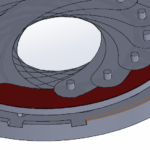Sometimes you need a mechanical iris that can close completely. One design that accomplishes this is the dual-plane iris diaphragm.
How it works…
A dual-plane iris consists of; one half of the blade array on one side, and the other half on the other side.
You’ll need to make a set of left-hand blades for one array, and a set of right-hand blades for the other. 1 set has the pin on top on one side, and the pin on the bottom on the other. The second set is opposite – pin on the bottom on one side, and the pin on the top on the other.
On each side of the actuator ring a ‘slip-blade’ is needed (shown in red below). This prevents the last blade from catching the pivoting end of the first blade in the half array, by encouraging it to slide up and over. Slip-blades are static, in that they don’t move, and are permanently retained in place in a ‘fully open’ orientation. They essentially straddle, or bridge, the area where typically the blades would be in a single-plane iris. This allows all the blades to stack correctly so that they still slide over one-another when the iris is operated.
You would obviously need slots (or pin holes if your slots are in the actuator ring) on both sides of the iris housing. All it really is, is a half-filled iris on one side of the actuator plane, and another half-filled iris on the other side. And by having the blade arrays separate, they are free to move beyond the center of the iris without meshing into one-another – as they do in a single-plane iris – allowing the iris to close completely.
Some notes about irises that close completely…
Because there is a gap between the two planes of blades, this dual-plane iris is ‘light tight’ but not water tight. You may want to look at a different type of mechanical iris if gas or water flow control is what you’re after.
See this interactive animation to give you a better idea of the whole concept (click ‘Next’ twice in the bottom right-hand corner to get to the blackout dual-plane).
Take a look at our article on making a quick cardboard mock-up version and blade making tips and tricks.







[…] sweeping gesture, allows copious amounts of light in, resulting in a brighter image. Conversely, a closed iris restricts the light, producing a darker image. This control over exposure is pivotal in crafting […]